How to Ride Out a Hurricane in a Marina

Hurricane Matthew Hits Beaufort, South Carolina
Compared to what he did to Haiti, Matthew treated Beaufort, South Carolina with kid gloves. Every moment of our “ordeal” my mind returned to Haiti. With every gust that seemed unsurvivable, I remembered pictures of the devastation there. Those pictures set us up to expect bad things here. We escaped virtually unscathed.
That’s not to say there’s no damage. In some areas pretty severe damage. Four days later, some still can’t get back home. But Matthew was a cat 2 when it arrived here, and though the whole event was upwards of 18 hours and the eye wall parked over us for about 8 hours, we have to remember that Matthew transited Haiti as a category 5. So I want to be absolutely clear that we are privileged. Our story and photos of what a storm can do might serve those who want to prepare for the next one. The little bit of wisdom we gleaned from the experience will allow us to do better in future storms. But in no way does what we went through here prepare us for surviving something like what hit Haiti, Cuba or the Bahamas.
I’d like to be able to do a split screen – on one side our small inconveniences and on the other the complete loss Haitian families suffered. But I think by now we all know the worst and that many people died.
Please donate to hurricane relief for Haiti, they are in need of everything and will be for some time. The storm struck during harvest and 90% of crops were destroyed.
Red Cross
UNICEF
CARE
Mercy Corps
Hurricane Prep: Expectations, Prognostications, Options and Insecurities
So why did we decide to ride out a hurricane in a marina?
In the week before Matthew arrived we laid in a stock of food, filled the water tanks, charged the batteries, bought spare dock lines, anchor lines and a bigger anchor. My son calls Sunshine a Ninja Warrior Training Platform. As with any sailboat, she’s basically a self contained survival pod. With all systems go, we scoped out places to take the boat to anchor and read treatises on hurricane anchoring on the internet, and debated whether to evacuate.
Meanwhile, we also watched the various possible tracks from the National Hurricane Center, which showed Matthew might do anything. One model had him benignly heading along the coast, well out to sea, another forecast a grazing of the South Carolina shore, and then a complete loop back through Florida.
Our best guess from the forecasts was that we’d experience something like 30 mph winds with gusts of 50 or 60. The initial winds would come from a direction that gave us home protection. And so, grasping for hope, that’s what we prepared for. The marina policy says boats must leave if a category 3 or above is coming. Matthew was forecast to be a 2 when he got here. So most owners left their boats in their slips and evacuated inland.
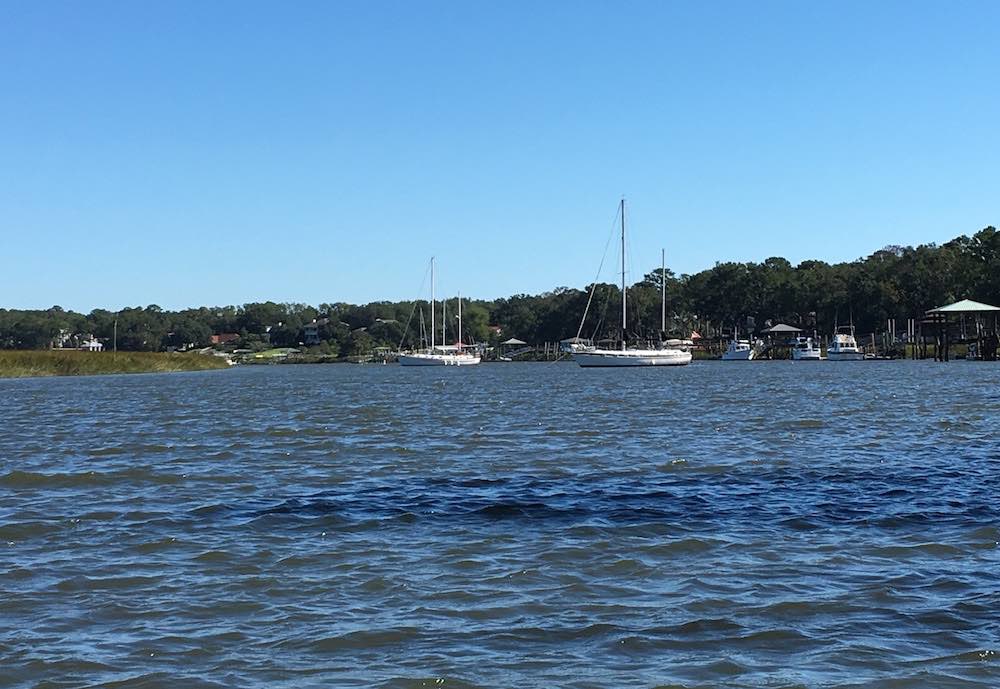
A few pulled out into the creek, up around the marsh which forms an oxbow sheltered from the northeast, the direction from which most of the winds would come. We planned to take Sunshine there too, but we were nervous. She’s a light boat, she might not ride well at anchor. We’d never anchored in winds over 40 before.
When we finally decided to stay at the dock, we along with three other boats, put anchors out into the creek as a fail-safe device. If the docks broke apart on the waves or floated above the pilings with the forecast 4 to 7 foot tidal surge, we could pull our boats free.

Team Work and Vigilance
About 7:00 Friday night we decided to take a break from the bouncing and yawing and went up to the lounge for a while before hunkering down for the night and the worst of the storm. We watched the hurricane news as Matthew churned through Georgia and shared snacks with the few other boat owners who hadn’t evacuated. When the power went out, about 8:30 or 9, we tried to go back to our boat and found that the storm had strengthened and the boat’s motion was so violent that we could hardly get aboard. After retying some damaged dock lines on neighboring boats we opted to go back to the lounge.
Throughout the night we all took turns checking all the docks, re-securing boats that had broken lines and threatened to float free. Our worst fear at that point was the domino effect of one loose boat crashing into the next, and the next.

Helplessness in the Face of Storm Surge
And then came the nightmare scenario, a surge at high tide.
A hurricane pushes water toward shore and when that surge combines with high tide very bad things can happen. A marina’s docks are built around a series of pilings, but they are not tied to those pilings. When the docks rise higher than the pilings the whole marina, boats and all, can float free.
The storm hit us on an incoming tide. The tide rose and rose, it achieved a normal high, then it rose past the point of an extreme high, and then it became a storm surge high. The upper docks flooded, the gangways reversed direction, the floating docks crept toward the tops of the pilings. One hour past normal high tide, two hours past, and still the water rose. We crowded around the windows, eyes glued on the nearest pilings, watching waves crash over the docks. Every few minutes someone would go out and check the water level in the lee of the building where there was less wave action.
We all started to think our fight was lost, we’d stayed behind for nothing, all our efforts were useless. And then Adam went out for the half hour check and came in with the report that the water had not risen since the last check. There were twelve inches of piling left. Over the next two hours the water slowly began to recede.
The Dark Night of the Uninsured Boater’s Soul
But still the storm battered. The wind clocked around and now came from the north. Rollers raised the boats and the docks until they resembled a jointed wooden children’s toy. They crashed sideways into the boats, and broke against the face of the building. Boats rocked side to side, scraping the docks, jerking against cleats and forcing us to reset lines and fenders again to accommodate the changed wind. We tried to get some sleep. But in reality, that possibility ended for me with the decision to ride out a hurricane.
There came a moment, hours into the night, the wind and the anxious sleeplessness when I finally had to give up or go crazy. Izzy’s boat was dismasted, many sails were shredded, the building shuddered with the impact of cresting waves. I couldn’t believe Sunshine could remain intact through the pounding she was taking.

We have no insurance on Sunshine. We bought her dirt cheap and in poor condition and haven’t yet had a survey to establish the value of the work we’ve done. But that was a problem I could not solve that night. And so I couldn’t continue to worry over what would happen. Instead, I gave up. I gave up my plans to cruise the Bahamas. I gave up living aboard, I gave up the money and the work we put in to bring Sunshine back to life.
I gave up books, clothes, kitchen equipment, supplies, parts and tools. I kissed it all goodbye. I decided that when dawn broke I’d be taking what I’d stored in the van and driven to high ground – our few valuables, my laptop, some clothes, business papers and important books – and driving west, back home to Washington, to start over. Because I was now homeless and there would be no insurance payout.
Giving up brought some relief from the anxiety. It actually allowed me to plan a different course for what to do next. That doesn’t mean I was able to sleep.
Dawn: Shock and Assessment
When the sun came up and we were finally able to see, my first reaction was amazement that every boat was still afloat. The docks however, looked wrecked. There was so much marsh grass covering everything that it looked like splintered wood. A reed sculpture after Andy Goldsworthy showed the high water line across the lawn.
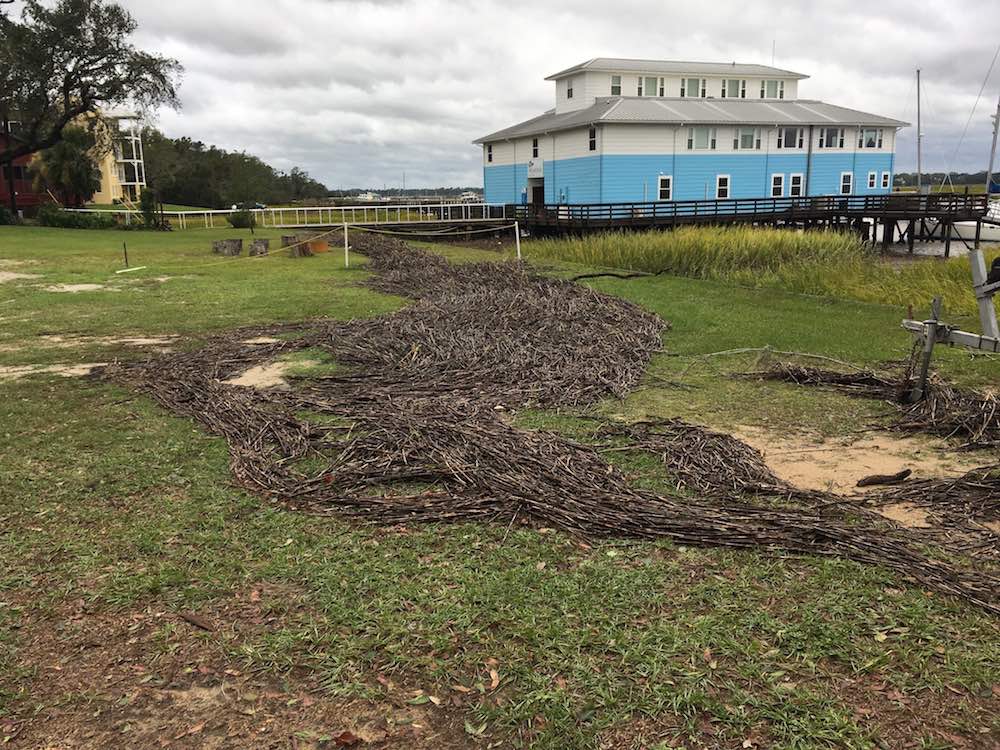
With the dawn, the wind clocked around again, now coming out of the west, and the wave action picked up. There’s a mile of fetch from the west, plenty of distance for the waves to build. Cresting waves rolled up the creek and the boats and docks surfed them.
Learning How Others Fared Against the Storm
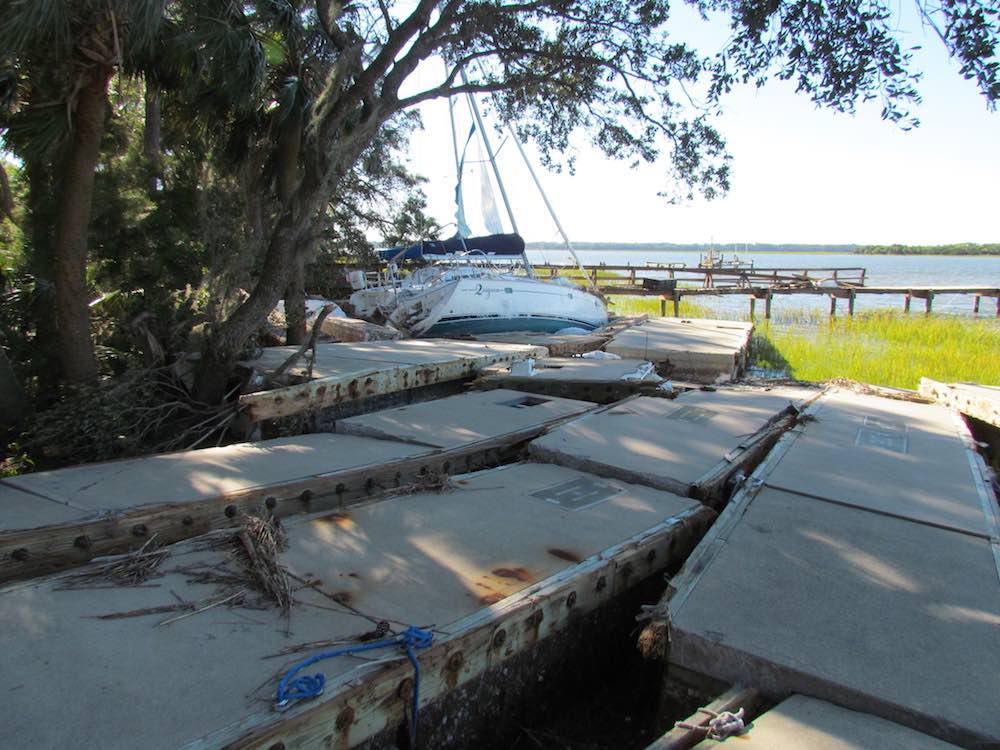
Little by little the winds diminished. We began to notice more time between gusts. News began to trickle in. Adam, who had a boat at another nearby marina, got a call from a friend who told him the Dataw Marina docks were gone, boats were sunk, his was one of the missing. There was a catamaran in the middle of the airport’s runway. The derelict boats in a nearby anchorage had all broken loose and were piled up on the beach.

Saturday evening, as the last few bands of wind and rain were moving through, Beth and John called from the Charleston airport where they had a hotel, invited the holdouts to join them there, for hot showers, lights, internet, swimming pool.
No one accepted. We had our stock of food, water, hot showers aboard our boats, lack of internet, solar lights and dark, starry skies. We were happy here in the lonely marsh.
Night in an Empty State
That night, in a town, a county, a state under an evacuation order, slammed by a hurricane yet undamaged, I sat down on the dock to write.
“There is no destruction. No one died. Yet the place is empty. Our normally busy marina, where thirty people live, and a hundred come and go every day, is down to a skeleton crew of ten. There’s no electricity, no light but the moon and the stars. I’m writing this by moonlight. I can’t really see the words, but that doesn’t matter because all I want to capture is how this feels. And how it feels is the way the world should be, empty.
Empty of busyness, empty of noise, air conditioners, cars and war planes. I can hear cicadas, crickets, lapping water. I can see the horizon, the clouds, and the stars. There’s no light pollution from dock electric pillars, no town as far as I can tell, even the lights of the bridge are out. Up the creek where the boats are anchored out, a few masthead lights shine, here in the marina one or two cabin lights, that is it, and it is glorious.”
Hurricane Tourism
We took a drive to Dataw and beyond. The destruction there was far worse than our area. Trees lay against the roofs of houses as if resting, leaving the structures strangely untouched. The marina however was a total loss. Adam’s boat turned out to be up in a neighboring yard, badly scraped and gouged but mostly intact. She’ll be hard to retrieve.

Farther out Sea Island Parkway we saw power lines tipped over, and the Hunting Island bridge was closed due to a sink hole on the east abutment.

No one had yet made it to Hunting Island to see if the light house and Little Blue had survived the storm. A pilot flew over and proved that, amazingly, the last state park cabin still stands above the waves.
Slow Return to Normal
At 9:30 Sunday morning, as I sat in the cockpit enjoying the quiet and the view of the sunny marsh, a shout of joy went up from the next dock. I looked that way and saw five yellow power company trucks coming across the bridge. I was sad. Normality would soon return. I like survival mode.
On Monday morning evacuees began to return, refugees arrived from Dataw. The power came on. The anchor crew retrieved the anchors from the creek. We returned borrowed equipment and got back things we’d loaned out.
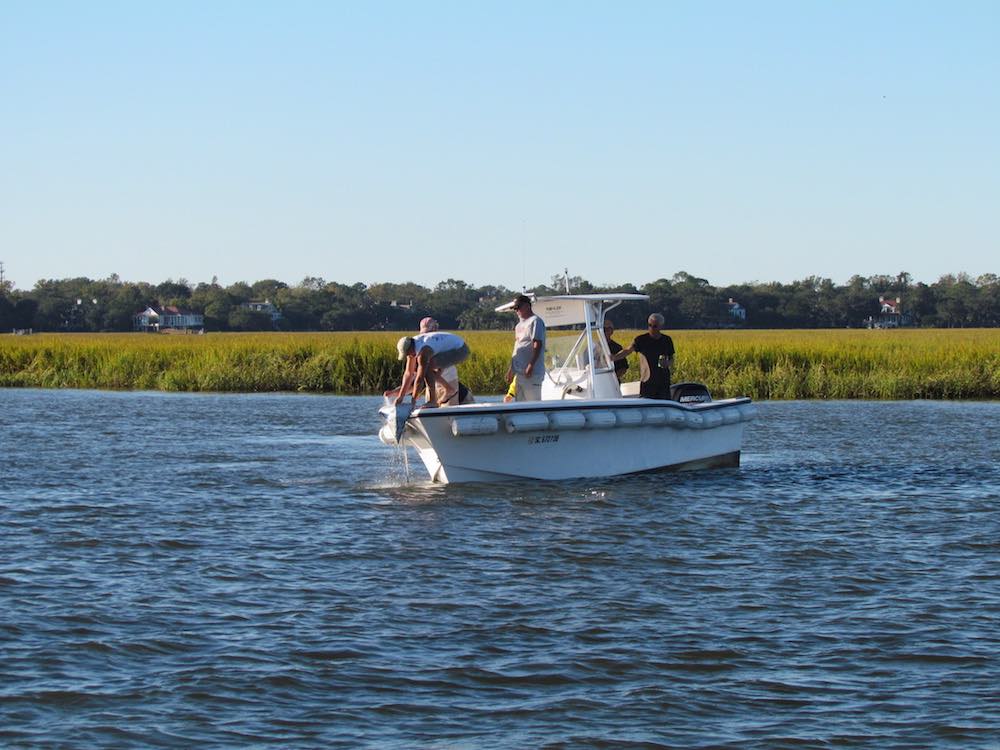
Post Hurricane Self Assessment
I know I’ve got what it takes to ride out a hurricane in a marina. Do I want to do it again? No. Once is enough for my bucket list.
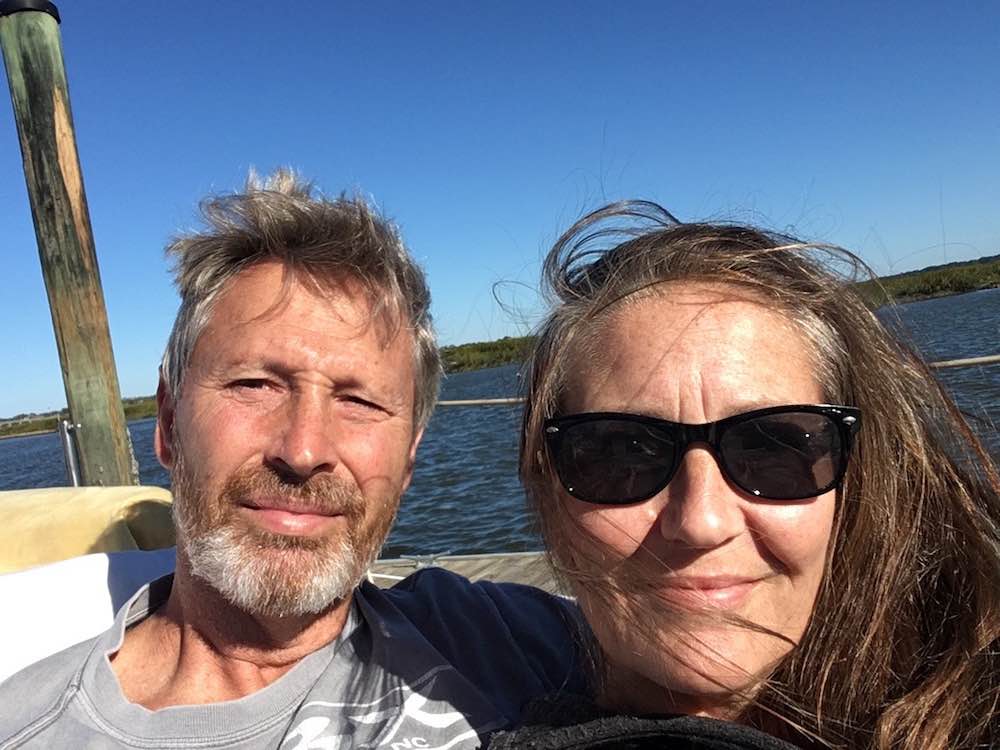
I was, we all were, too willing to accept the best case scenario forecast that said Matthew would stay offshore, and we’d see only 30 mph winds. In reality we should have mentally prepared ourselves for the very worst case, a direct hit and winds of 100 mph.
Will I ride out a hurricane at anchor? You just never know, so the preparations start now.
Changes for Next Time
From here on, we’ll plan as if all hurricanes are coming right at us at cat 5. While Nicole – with 100 mph winds, wandered around off shore before finally heading toward Bermuda (good for us, not so good for Bermuda) I looked at how far inland we can take Sunshine without running into a bridge. There’s a boatyard that can haul her up on dry land. And I told Tom that during the next (non-hurricane) storm I want to anchor out. For the practice. Okay, maybe for the bucket list.
Related Posts:
To Do List: Prepping to Ride Out a Hurricane In a Marina
20 Key Products for Marina Based Hurricane Survival
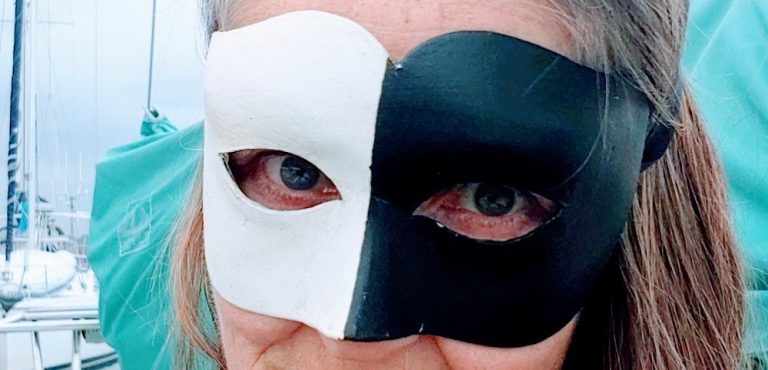

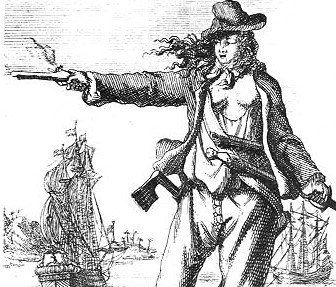

Thanks Tim. We heard your storm was pretty strong at the coast but milder inland. Hope you fared well. Tell everyone we say hello.
Me too!